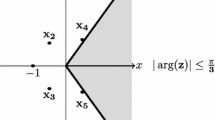Abstract
We use the so-calledreflection coefficients (RCs) to examine, review, and classify the Schur-Cohn and Marden-Jury (SCMJ) class of tests for determining the zero location of a discrete-time system polynomial with respect to the unit circle. These parameters are taken as a platform to propose a partition of the SCMJ class into four useful types of schemes. The four types differ in the sequence of polynomials (the “table”) they associate with the tested polynomials by scaling factors: (A) a sequence of monic polynomials, (B) a sequence of least arithmetic operations, (C) a sequence that produces the principal minors of the Schur-Cohn matrix, and (D) a sequence that avoids division arithmetic. A direct derivation of a zero location rule in terms of the RCs is first provided and then used to track a proper zero location rule in terms of the leading coefficients of the polynomials of the B, C, and D scheme prototypes. We review many of the published stability tests in the SCMJ class and show that each can be sorted into one of these four types. This process is instrumental in extending some of the tests from stability conditions to zero location, from real to complex polynomial, in providing a proof of tests stated without a proof, or in correcting some inaccuracies. Another interesting outcome of the current approach is that a byproduct of developing a zero location rule for the Type C test is one more proof for the relation between the zero location of a polynomial and the inertia of its Schur-Cohn matrix.
Similar content being viewed by others
References
P. G. Anderson, M. R. Garey, and L. E. Heindel, Combinational aspects of deciding if all roots of a polynomial lie within the unit circle,Computing, vol. 16, pp. 293–304, 1976.
S. Barnett,Polynomials and Linear Control Systems, New York and Basel: Marcel Dekker, 1983.
Y. Bistritz, Zero location with respect to the unit circle of discrete-time linear system polynomials,Proc. IEEE, vol. 72, pp. 1131–1142, Sep. 1984.
Y. Bistritz, A circular stability test for general polynomials,Systems & Control Letters, vol. 7, pp. 89–97, April 1986.
Y. Bistritz, Reflections on Jury tables through reflection coefficients,Proc. Symposium on fundamentals of discrete-time systems in honor of Prof. E. I. Jury, M. Jamshidi et al. eds., Chicago, IL, June 1992.
Y. Bistritz, H. Lev-Ari, and T. Kailath, Immittance domain Levinson algorithms,IEEE Trans. Information Theory, vol. 35, pp. 674–682, May 1989.
C. F. Chen and H. W. Chan, A note on Jury's stability test and Kalman-Bertram's Liapunov function,Proc. IEEE, vol. 73, pp. 160–161, 1985.
C. F. Chen and C. H. Shiao, Stability tests for singular cases of discrete systems,Circuits Systems Signal Processing, vol. 8, pp. 123–132, 1989.
A. Cohn, Über die Anzahl der Wurzeln einer algebraischen Gleichung in einem Kreise,Math. Z., vol. 14, pp. 110–148, 1922.
M. Fujiwara, Über die algebraische Gleichungen, deren Wurzeln in einem Kreise order in einer Halbebene liegen,Math. Z, vol. 24, pp. 161–169, 1926.
I. C. Gohberg and A.A. Semencul, On the inversion of finite Toeplitz matrices and their continuous analogs,Mat. Issled., 7, pp. 201–223, 1972 (in Russian).
E. I. Jury, Further remarks on a paper “Über die Wurzelverteilung von linearen Abtastsysteman,” by M. Thoma [8],Regelnungstednik, vol. 2, pp. 75–79, 1964.
E. I. Jury,Theory and Applications of the Z-Transform Method, New York: Wiley, 1964.
E. I. Jury, A modified stability table for linear discrete systems,Proc. IEEE, vol. 53, pp. 184–185, Feb. 1965.
E. I. Jury, Inners approach to some problems of system theory,IEEE Trans. Automat. Control, vol. AC-16, pp. 233–240, 1971.
E. I. Jury,Inners and the Stability of Linear Systems, New York: Wiley, 1982.
E. I. Jury, Addendum to “Modified stability table for 2-D digital filter” Dept. Elect. Comp. Eng., Univ. Miami, Coral Gables, FL, internal rep., March 1987.
E. I. Jury, Modified stability table for 2-D digital filter,IEEE Trans. Circuits and Systems, vol. CAS-35, 116–119, 1988.
E. I. Jury, A note on the modified stability table for linear discrete time systems,IEEE Trans. Circuits and Systems, vol. CAS-38, 221–223, 1991.
E.I. Jury and J. Blanchard, A stability test for linear discrete systems in table form,I.R.E. Proc., vol. 49, pp. 1947–1948, 1961.
M. G. Krein and M. N. Naimark, The method of symmetric and Hermitian forms in the theory of the separation of roots of algebraic equations,Linear and Multilinear Algebra, vol. 10, pp. 265–308, 1981 (originally in Russian, Kharkov 1936.)
H. Lev-Ari, Y. Bistritz, and T. Kailath, Generalized Bezoutians and families of efficient zerolocation procedures,IEEE Trans. Circuits and Systems, vol. cas-38, pp. 170–186, 1991.
H. Lev-Ari and T. Kailath, Lossless cascade networks: The crossroads of stochastic estimation, inverse scattering and filter synthesis,Proc. 1987 Int. Symp. Circuits and Systems, pp. 1088–1091, Philadelphia, PA, May 1987.
N. Levinson, The Wiener rms (root mean square) error criterion in filter design and prediction,J. Math. Phys., vol. 25, pp. 261–278, 1946.
M. Marden, The number of zeros of a polynomial in a circle,Proc. Nat. Acad. Sci. U.S.A., vol. 34, pp. 15–17, 1948.
M. Marden,The Geometry of Polynomials, Providence, RI: Amer. Math. Soc, 1966.
G. A. Maria and M. M. Fahmy, On the stability of two-dimensional digital filters,IEEE Trans. Audio and Electroacous., vol. AU-21, pp. 470–472, 1973.
J. D. Markel and A. H. Gray,Linear Prediction of Speech, New York and Berlin: Springer-Verlag, 1978.
R. H. Raible, A simplification of Jury's tabular form,IEEE Trans. Automat. Control, vol. AC-19, pp. 248–250, 1974.
I. Schur, Über Potenzreihen, die in Innern des Einheitskreises Beschränkt Sind,J. Reine Angew. Math., vol. 147, pp. 205–232, Berlin, 1917, and vol. 148, pp. 122–145, Berlin, 1918.
A. Vieira and T. Kailath, On another approach to the Schur-Cohn criterion,IEEE Trans. Circuits and Systems, vol. CAS-24, pp. 218–220, 1977.
Author information
Authors and Affiliations
Additional information
This research was supported by Grant No. 88-425 from the United States-Israel Binational Science Foundation (BSF), Jerusalem, Israel.
Rights and permissions
About this article
Cite this article
Bistritz, Y. Reflections on Schur-Cohn matrices and Jury-Marden tables and classification of related unit circle zero location criteria. Circuits Systems and Signal Process 15, 111–136 (1996). https://doi.org/10.1007/BF01187696
Received:
Accepted:
Issue Date:
DOI: https://doi.org/10.1007/BF01187696




